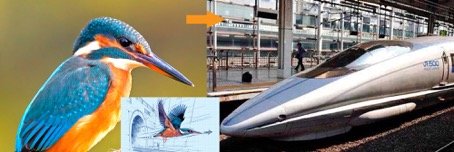Kingfisher Bullet Train

Kingfishers Inspired Japanese Bullet Trains
Kingfishers fly low and straight like bullets, reaching up to 25 miles per hour, but it’s not their speed that excites scientists; it’s their beaks. Sharp, pointed, and so long that they make up a third of a kingfisher’s height, these beaks slice soundlessly through water meaning kingfishers can dive into pools without alerting fish. Engineers working on Japan’s high-speed bullet train copied the shape of this beak to prevent sonic boom whenever these fast-moving trains enter a tunnel.
The length of a kingfisher’s beak can be something of a hindrance when it comes to feeding the chicks in the pitch black of an underground nest. But these birds have an ingenious answer to this problem: the chicks have a white tip to their beaks and their parents have a white flash on each side of their face, providing a luminous visual clue.
Main Image

Science from Nature

